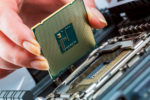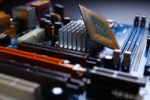Best Motherboard for Ryzen 9 5900x: Complete Reviews With Comparisons

Upgrading to the 5900x from the 3900x does not necessarily require a motherboard upgrade.
However, if you need the 20% speed boost from the 5900x, you should also check that your motherboard can keep up with the pace.
If push comes to shove and a complete hardware replacement is needed, you should get the best motherboards for Ryzen 9 5900x.
We have come up with a list of five outstanding motherboards to help you pin down excellent options.
Comparison Chart
Motherboard for Ryzen 9 5900x Reviews
1. ASUS ROG Crosshair VIII Formula
The Crosshair VIII Formula is a top-of-the-line motherboard from the ASUS ROG lineup.
It features excessive components for gaming and overclocking, and it is a very attractive ATX motherboard.
Review
If you pair the Crosshair VIII Formula with the 5900x, you could have a monster in your hands.
You’d be able to enjoy years of uninterrupted gameplay and content creation with easy-to-understand onboard controls and UEFI.
Of course, you’ll have to make sure you pair it with the right graphics card or multi-graphics setups.
ALSO READ: Best AM4 Motherboard
- Memory Slots
The Crosshair VIII Formula can hold up to four memory modules, each with a maximum capacity of 32GB.
At regular RAM operation, this motherboard can run memory speeds of up to 3200MHz.
With overclocking, maximum memory speeds can go as fast as 4800MHz.
- Expansion Sockets
The expansion sockets in the Crosshair VIII Formula include three full-sized sockets and a single x1 slot.
ASUS has the first two x16 sockets fully reinforced and surrounded by a massive heatsink that spreads over the chipset area.
Thanks to its three full-sized expansion slots, it can run multiple graphics cards using NVIDIA 2-Way SLI, AMD 3-Way CrossFireX, or AMD 2-Way CrossFireX.
- Storage Interface
The storage interface on this motherboard comprises eight SATA 6Gbps ports and two M.2 sockets.
Both M.2 sockets can connect with PCIe 4.0 and SATA drives, and all SATA storage devices can use Raid 0, 1, and 10.
- Back Panel Ports
Looking at its rear panel, the board does not have any display connectors.
Even so, the absence of display connectors is not so much of a disadvantage, as you would probably be using this board with a high-end GPU.
Ergo, you can always use the display connectors on the GPU.
Another high-end feature of this board is its premium gold-plated audio jacks with an optical S/PDIF out port.
With these, you can expect round-the-clock access to highly immersive sounds.
When it comes to network connectivity, this board does not hold back either.
It has an Aquantia 5G LAN, an Intel Gigabit LAN, and the latest Intel Wi-Fi 6 AX200 module.
What the board gets rid of in display connectivity, it replaces with plenty of USB ports, a Clear CMOS button, and a BIOS Flashback button.
You will find four USB 3.2 Gen1 ports and eight USB 3.2 Gen2 ports, one of which is a Type-C.
- Onboard Headers
If the rear panel USBs aren’t enough, you can course nine more USBs to the front panel through internal connections.
Since exceptional performance requires comprehensive cooling components, the board does not fall short on cooling headers.
All in all, it has at least eight fan headers, five headers for water-cooling devices, and a thermal sensor header.
You can also increase your rig’s overall aesthetic value by populating two Aura RGB headers and two addressable Gen2 headers.
Finally, the board includes a lot of features for extreme overclockers.
You will find an LN2 header, a Slow Mode switch, a Reset button, a Safe Boot button, a ReTry button, and a Power-On button.
PROS
CONS
2. ASUS ROG Strix B550-F Gaming Wi-Fi
If you need a pocket-friendlier motherboard that still has overclocking capabilities, check out the ASUS ROG Strix B550-F Gaming Wi-Fi.
It is also an ATX gaming motherboard but with less of the overkill features of the Crosshair.
Review
The ROG Strix B550-F Gaming Wi-Fi is not as robust as the Crosshair, but it is robust nonetheless.
It offers easy overclocking with the 5900x, and it can run almost any gaming or production software without any problems.
- Memory Slots
Like the Crosshair VIII Formula, the Strix B550-F Gaming Wi-Fi sports a maximum base memory rate of 3200MHz.
It also has a maximum RAM capacity of 128GB if you populate all four memory slots with 32GB modules.
However, if you pair the latter with the right components and overclock it using the correct settings, memory speeds can go as fast as 5100MHz.
- Expansion Sockets
When it comes to expansion options, the Strix B550-F Gaming Wi-Fi only has two full-sized sockets.
Also, only one of them is reinforced. If you only need two GPUs, then this should be enough.
Keep in mind that you can only use the AMD 2-Way CrossFireX Technology for multi-graphics setups.
Another advantage of the Strix B550-F Gaming over the Crosshair VIII Formula is its three x1 sockets.
You can add more expansion cards for other purposes if you think of any that you might need.
- Storage Interface
Since the Strix B550-F Gaming belongs to a somewhat earlier generation of motherboards, it can hold a maximum of six SATA 6Gbps storage devices.
Nevertheless, you can always populate the two M.2 slots with one more SATA drive each.
The first M.2 slot supports PCIe 4.0 drives, while the second can only hold PCIe 3.0 modules.
- Back Panel Ports
You can use this motherboard without a graphics card since it still has a DisplayPort and an HDMI port.
The problem is that you won’t be able to max out on the specs of the 5900x.
Use these ports instead for additional displays, and get your rig’s full potential by pairing it with a good GPU.
After runs and tests, the audio components on the Strix B550-F Gaming are comparable with those on the Crosshair VIII Formula.
This board also has five premium audio jacks that come with an optical S/PDIF out port.
For network connectivity, it has the Intel Wi-Fi 6 AX200.
However, it only offers 2.5Gb wired connections using the embedded Intel I225 Ethernet module.
Peripheral device connectors include four USB 3.2 Gen1, two USB 3.2 Gen2, and two USB 2.0.
We don’t like that it still has USB 2.0 ports, but we appreciate that one of the 3.2 Gen2 ports is a Type-C.
Lastly, you will find that the rear panel also has a BIOS Flashback button as an added feature.
- Onboard Headers
If you need more USBs, you can route six more to the front panel from the onboard headers.
You’d be able to take advantage of the board’s capable 14-phase power delivery system by maxing out its cooling connectors.
While it may only have five fan headers, you can incorporate a water-cooling system with its lone AIO Pump connector.
The board also has a thermal sensor connector.
For additional aesthetics, there are two Aura RGB headers and a single addressable Gen2 connector.
Extra internal features include one Thunderbolt header and a Clear CMOS jumper.
PROS
CONS
3. Gigabyte B450I Aorus Pro Wi-Fi
For those seeking to build a miniature gaming PC, the Gigabyte B450I Aorus Pro Wi-Fi is perfectly capable of handling gaming loads.
It is a mini-ITX motherboard packed with the essential components to keep the most valued games running smoothly.
Review
Any miniature PC can provide exceptional performance with the Gigabyte B450I Aorus Pro.
It pairs well with the 5900x, especially for those who do not like overclocking as an option.
One fallback with this B450 motherboard is its much slower PCIe 3.0 expansion slot.
- Memory Slots
Since it has a mini-ITX form factor, the B450I Aorus Pro only has two DDR4 DIMM slots.
This number of slots means it can only hold up to 64GB of RAM.
While all the alternatives offer maximum base clock speeds of 3200MHz, this motherboard can only run up to 2933MHz.
Even overclocking can only provide memory rates of 3600MHz.
Nevertheless, a base memory speed of 2933MHz is already high for those who do not need to overclock.
- Expansion Sockets
The B450I Aorus Pro has a single fully-reinforced full-sized expansion slot, which is another disadvantage of the mini-ITX form factor.
With this snag, the board cannot support multiple graphics cards.
The board also has a single M.2 expansion socket for the wireless module.
- Storage Interface
The mini-ITX form factor only permits this board to have four SATA 6Gbps connections and one M.2 storage connection.
Choosing a small form factor motherboard lets you build more miniature PCs by not allowing plenty of storage drives.
- Back Panel Ports
While you can only use one GPU with this motherboard, it allows multiple displays with its DisplayPort and two HDMI ports.
However, you might want to invest in a sound system or headset that uses fewer connectors, as the board only has three primary audio jacks.
It also doesn’t have an optical S/PDIF out port.
The B450I Aorus Pro has an Intel GbE LAN chip and a dual-band Wi-Fi 5 802.11AC module for network connections.
Among the options, this motherboard may have the fewest amount of USB ports.
It only has four USB 3.2 Gen1, two USB 3.2 Gen2, and no Type-C.
Even so, it is a good thing that Gigabyte already rid it of the older and slower USB 2.0.
- Onboard Headers
If the back panel USBs aren’t enough, you can only add two more through internal headers.
Gigabyte did not intend this motherboard for extreme overclocking, as it only has two fan headers.
On the flip side, you can customize your PC’s internal lights using one digital LED strip and one RGB LED strip.
Added internal features include a TPM connector, a Clear CMOS jumper, and a chassis intrusion header.
PROS
CONS
4. MSI MAG B550M Mortar Wi-Fi
Having the MSI MAG B550M Mortar Wi-Fi lets you build a small PC.
It is a micro-ATX form factor board with more features than the mini-ITX B450I Aorus Pro Wi-Fi.
Furthermore, it features the more advanced B550 chipset.
Review
Instead of settling for the smooth-running B450I Aorus Pro, why not pick things up a notch and go with the more capable MAG B550M Mortar?
It offers better features for taming the 5900x, as it does not sacrifice so many essential components.
- Memory Slots
An advantage of a micro-ATX motherboard is its small form factor.
What’s more, you’ll like that it doesn’t reduce the number of memory modules you can have.
The MAG B550M Mortar has four DDR4 DIMM slots that are fully capable of holding up to 128GB of system RAM.
Base memory speeds can go as high as 3200MHz, and overclocking can give you rates of up to 4400MHz.
- Expansion Sockets
In addition, the micro-ATX form factor does not sacrifice your expansion options.
The MAG B550M Mortar sports two full-sized expansion sockets and MSI has reinforced the primary socket.
With the primary socket, you can use PCIe 4.0 devices.
Use the two x16 sockets for a multi-graphics setup using 2-Way AMD CrossFire Technology.
The board also has two PCIe 3.0 x1 slots for smaller expansion cards.
- Storage Interface
The storage interface of the MAG B550M Mortar is similar to most ATX motherboards.
It has six SATA 6Gbps ports and two M.2 slots.
However, installing an SSD on the second M.2 slot disables the second full-sized expansion socket.
As such, you will have to sacrifice a multi-GPU setup if you need an SSD on the M.2 slot.
- Back Panel Ports
You can use the rear panel of the MAG B550M Mortar to connect a DisplayPort cable and HDMI cable.
The board features high-quality sound I/O with its five HD audio jacks and an optical S/PDIF out port.
Furthermore, you can also use legacy peripherals with the built-in PS/2 combo port.
Wireless gaming is at its best with the Wi-Fi 6 AX200, but you can always settle for a wired connection using the Realtek LAN controller.
The only thing we found lacking on the rear panel is high-speed USBs.
It only has two USB 2.0, two USB 3.2 Gen1, and two USB 3.2 Gen2. Fortunately, one of the USB 3.2 Gen2 ports is a Type-C.
- Onboard Headers
You can have seven more USB ports using the internal headers, and one of them is a Type-C.
Like the Strix B550-F Gaming, the MAG B550M Mortar only has five fan headers.
If you need a water-cooling system, one of the headers converts to a pump connector.
RGB lighting aesthetics are a bit better than those on the B450I Aorus Pro.
The MAG B550M Mortar comes with two RAINBOW LED connectors and one RGB strip header.
Other than that, all extra features are similar, including the TPM connector, Clear CMOS jumper, and the chassis intrusion header.
PROS
CONS
5. MSI MPG B550 Gaming Edge Wi-Fi
If you want full ATX motherboard features but need to cut back more on costs, go for the MSI MPG B550 Gaming Edge Wi-Fi.
It can save you a few bucks, and it can provide almost the same capabilities as the Strix B550-F Gaming.
RELATED:
Motherboard for Ryzen 9 3950x (Guide)
Review
If you need comprehensive cooling devices to max out the speeds of the 5900x, the MPG B550 Gaming Edge is a perfect choice.
This board allows you to increase airflow and reduce the heat gain on the massive heatsinks.
- Memory Slots
Similar to our ATX and micro-ATX alternatives, the MPG B550 Gaming Edge features four DDR4 DIMM slots.
These slots are capable of holding a maximum RAM capacity of 128GB.
This board also has a max base memory speed of 3200MHz, but it can overclock to 5100MHz like the Strix B550-F Gaming.
- Expansion Sockets
Another similarity with the Strix B550-F Gaming is this board’s dual full-sized expansion sockets.
The first socket has a reinforcement, and it can also run PCIe 4.0 devices.
With the second x16 socket running a PCIe 3.0 GPU, you can use two graphics cards with the AMD 2-Way CrossFire Technology.
The only difference between the two motherboards is this board’s one less PCIe 3.0 x1 expansion slot.
- Storage Interface
Everything is also pretty much similar in the storage department with the Strix B550-F Gaming.
The MPG B550 Gaming Edge has six SATA 6Gbps sockets and two M.2 slots.
While the first M.2 slot supports both SATA and PCIe 4.0, the second M.2 slot only allows PCIe 3.0 connections.
- Back Panel Ports
When it comes to the rear panel input and output ports, everything is precisely the same as the ones on the MAG B550M Mortar.
The only difference you will find is the positioning of the DisplayPort and HDMI ports.
- Onboard Headers
If you look closely at the onboard headers, the MPG B550 Gaming Edge offers a slight advantage over the MAG B550M Mortar.
Additional USBs and extra features are also the same, but it has more fan headers and RGB connectors.
The MPG B550 Gaming Edge features as many fan headers as the Crosshair VIII Formula.
However, you will need to use one of those headers to install a water pump.
In addition to the two addressable RGB headers, this board has two 4-pin RGB connectors instead of just one.
PROS
CONS
Final Verdict
If you can do away without having more than six SATA ports and a 5G wired connection, the Crosshair VIII Formula can be overkill.
For more cost-effectiveness, the top motherboard for Ryzen 9 5900x is the Strix B550-F Gaming Wi-Fi.
It provides highly immersive audio, and it carries the latest in wireless technology.
Moreover, you can max out your Ryzen 9 5900x with the board’s straightforward overclocking solution.
However, if you need a small form factor board, the MSI MAG B550M Mortar is a slightly better buy than the Gigabyte B450I Aorus Pro.














